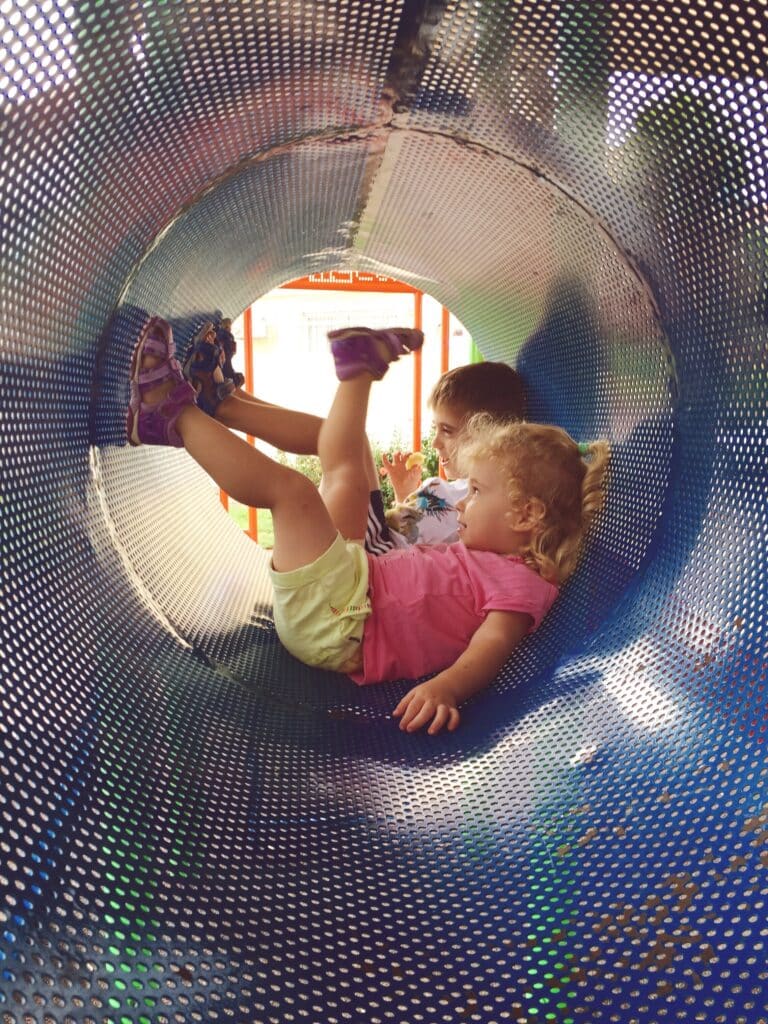Article by: Lauren Gay, COTA/L
Children’s sensory development plays a pivotal role in shaping their experiences and overall well-being. Understanding and catering to their sensory needs is fundamental for parents, educators, and caregivers. Within this realm, two essential categories—sensory seeking activities and heavy work activities—hold significant sway in fostering a child’s sensory development. These activities are not just about play; they are vital tools that contribute to a child’s growth, aiding in their physical, cognitive, and emotional development.
In this blog post, we’ll dive into the distinctions between sensory seeking and heavy work activities, exploring their distinct roles in children’s lives. From the exhilarating sensory-seeking behaviors to the grounding effect of heavy work activities, this exploration aims to shed light on the significance of these practices in the world of pediatric development. Whether you’re a parent, an educator, or anyone engaged in nurturing young minds, understanding these activities can significantly impact how you support and encourage children in their developmental journey.

Let’s take a closer look at these activities, their benefits, and how they can be integrated into children’s routines for a more wholesome developmental experience.
Sensory seeking activities encompass a range of behaviors in children where they actively seek sensory input. This can manifest in various ways, such as seeking movement, touch, or particular sensory experiences. Some common examples of sensory seeking behaviors include spinning, jumping, seeking deep pressure through hugs or weighted blankets, seeking different textures to touch or feel, and actively exploring sensory-rich environments like sand or water play.
These activities are more than just ways for children to have fun—they serve a crucial purpose in fulfilling a child’s sensory needs. For instance, spinning or jumping activities provide the vestibular input that helps regulate a child’s sense of balance and spatial orientation. Seeking deep pressure through activities like hugs or using compression garments can have a calming effect, assisting children in self-regulation. Similarly, exploring different textures allows children to understand and process sensory information, aiding in their sensory integration skills.
By engaging in these activities, children can enhance their focus, regulation, and overall sensory processing abilities. Sensory seeking activities can be particularly beneficial for children with sensory processing differences or those who may be sensitive to certain sensory inputs. Providing these opportunities allows children to regulate their sensory systems, ultimately supporting their overall development.
Heavy work activities involve tasks or movements that provide deep pressure input to the muscles and joints. These activities offer proprioceptive input, which is essential for a child’s body awareness, coordination, and sensory processing. Examples of heavy work activities include pushing, pulling, carrying, lifting, squeezing, or engaging in activities that involve resistance, such as pushing against a wall or carrying weighted objects.
Through these activities, children receive sensory input that helps them regulate their sensory systems. For instance, pushing or pulling heavy objects, like a loaded cart or carrying a weighted backpack, provides deep pressure input, aiding in the regulation of the sensory system. The input from these activities can have a calming effect, helping children focus, concentrate, and self-regulate. Other activities, like climbing, jumping, or participating in sports that involve resistance, can also offer beneficial sensory input.

Heavy work activities are especially beneficial for children who may experience challenges with sensory modulation or regulation. Engaging in these tasks can help them better navigate their environment and develop a stronger sense of body awareness. Moreover, these activities contribute to improving coordination, strength, and overall sensory integration skills, which are crucial for a child’s development.
While both sensory seeking and heavy work activities cater to a child’s sensory needs, they differ in the type of sensory input they provide and the subsequent impact on a child’s regulation and development.

Heavy Work Activities:
- Nature of Input: Heavy work activities involve providing deep pressure input to muscles and joints, contributing to a child’s body awareness and sensory processing.
- Examples: Pushing, pulling, lifting, carrying, squeezing, engaging in activities that involve resistance, like climbing or participation in sports with resistance.
- Purpose: These activities offer proprioceptive input that aids in regulating a child’s sensory system. They aim to calm, ground, and aid in a child’s self-regulation.
- Impact: Heavy work activities help in improving a child’s body awareness, coordination, strength, and sensory integration skills, aiding in self-regulation and overall development.
Heavy Work Activities:
- Nature of Input: Heavy work activities involve providing deep pressure input to muscles and joints, contributing to a child’s body awareness and sensory processing.
- Examples: Pushing, pulling, lifting, carrying, squeezing, engaging in activities that involve resistance, like climbing or participation in sports with resistance.
- Purpose: These activities offer proprioceptive input that aids in regulating a child’s sensory system. They aim to calm, ground, and aid in a child’s self-regulation.
- Impact: Heavy work activities help in improving a child’s body awareness, coordination, strength, and sensory integration skills, aiding in self-regulation and overall development.

Key Difference:
The primary distinction lies in the nature of input and the resultant impact on a child’s sensory processing. Sensory seeking activities focus on seeking specific sensory experiences to energize or engage, whereas heavy work activities aim to provide deep pressure input for calming and grounding effects, aiding in self-regulation.
Implementing Sensory Strategies for Parents, Teachers, and Caregivers:
- Understanding Individual Needs:
- Observation and Communication: Pay attention to a child’s reactions to different sensory stimuli. Communicate with the child (if possible) to understand their preferences and aversions to sensory input.
- Collaboration: Work with occupational therapists or specialists to gain insights into a child’s specific sensory needs and create tailored strategies.
- Creating Supportive Environments:
- Sensory-Friendly Spaces: Design environments that accommodate different sensory preferences, such as offering quiet spaces, varied textures, or adjustable lighting.
- Consistency and Predictability: Maintain routines and provide clear transitions to help children anticipate sensory experiences.
- Incorporating Sensory Activities:
- Daily Routines: Integrate sensory activities into daily schedules, such as incorporating movement breaks, tactile experiences, or heavy work activities.
- Flexibility in Learning: Allow for flexible seating options, like exercise balls or cushions, in classrooms to accommodate various sensory needs.
- Education and Communication:
- Parent Education: Educate parents on the significance of sensory activities and strategies, providing resources and ideas for implementation at home.
- Collaboration with Educators: Foster communication between parents and teachers to ensure consistency in implementing sensory strategies across home and school settings.
- Individualized Approach:
- Tailoring Strategies: Customize sensory activities based on the child’s preferences and sensory profiles. What works for one child might not work for another.
- Trial and Observation: Experiment with different activities and observe the child’s responses to determine what is most effective.
- Sensory Regulation Techniques:
- Calming Strategies: Teach children self-regulation techniques, such as deep breathing, using sensory tools like fidget toys, or engaging in calming activities when needed.
- Sensory Diet: Develop a personalized ‘sensory diet’—a structured schedule of sensory activities—to meet a child’s sensory needs throughout the day.
By implementing these strategies, parents, teachers, and caregivers can create supportive environments and incorporate sensory activities that cater to the diverse sensory needs of children, promoting their overall well-being and development.
Understanding the intricacies of sensory seeking and heavy work activities is pivotal in nurturing the holistic development of children. These activities, designed to cater to diverse sensory needs, play a profound role in shaping a child’s experiences and abilities.
From the exhilaration of sensory seeking behaviors to the grounding effect of heavy work activities, the spectrum of sensory strategies provides an avenue for supporting children’s sensory processing and integration. By incorporating these activities into their routines, parents, educators, and caregivers can create environments that promote self-regulation, focus, and overall well-being.
Whether it’s creating a sensory-friendly classroom, integrating movement breaks, or providing tools for sensory regulation, the impact on a child’s attention, regulation, and emotional control is palpable.
In embracing these strategies, it’s crucial to acknowledge the uniqueness of each child’s sensory profile and the necessity of individualized approaches. Collaboration between parents, educators, and specialists is key to tailoring sensory activities that best suit a child’s needs, thereby fostering a supportive environment for growth and development.
By implementing these strategies thoughtfully and consistently, we can empower children to navigate their sensory experiences, develop essential life skills, and thrive in their journey toward a balanced, well-rounded future.


